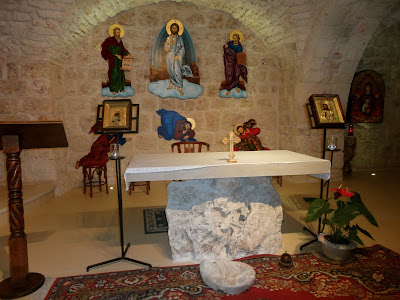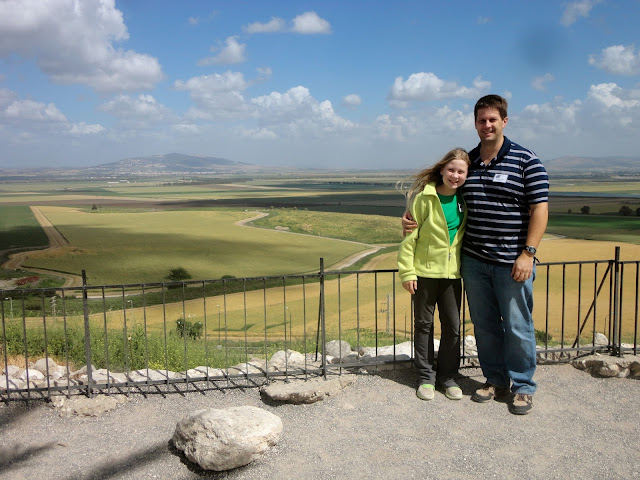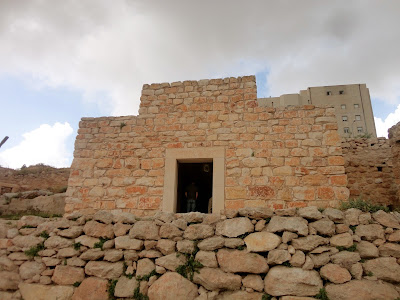The tour is run by people with a deep, deep knowledge of the Bible, archeology, and connecting the Old Testament to the New Testament. They are making the Bible really come alive and I can see it in the girls' eyes (especially H).
It feels a little like drinking water from a fire hydrant with a straw, but I am thankful I have my little 'notepad' on the iPhone as I type away as fast as I can while the guide is talking.
Some highlights:
April 4
Caesarea has 3 main points of Biblical significance:
1. In Acts 10, Cornelius is the first Gentile to be baptized into Christianity at Caesarea. Before that all new Christians were Jews who accepted that Jesus was the Messiah. This began the outreach to the Gentiles. Cornelius almost certainly attended events at this amphitheater:
2. Paul was imprisoned at Caesarea for perhaps as much as 2 years before being sent to Rome for his trial. It is believed that a number of the letters that would become part of the New Testament were written from here. V mentioned that 'it is really neat to be standing at the place where part of the New Testament was written!' She and the other girls are going to have the feeling a lot over the next 2 weeks!
The Palace was built out into the ocean and was surrounded on 3 sides by water. Herod the Great built the palace before the time of Jesus' birth. He was the Roman leader who tried to kill Jesus as a baby and the one who met with the 'wise men' His son also lived here (Herod Antipias)...we call him Herod Jr. Herod Jr killed John the Baptist (that may have happened here as well). In addition, Herod Jr. was in Jerusalem on the day of Jesus' crucifixion and Jesus was sent to him that morning before being sent back to Pontius Pilate.
The 'floor' of the palace down by the ocean is remarkable (last pictures).
3. Caesarea is the only place where an archeological find has identified Pontius Pilate. We learned that Pontius Pilate lived in Caesarea and traveled often to Jerusalem as part of his responsibilities. While he lived in Caesarea he built a Temple in honor of Tiberius (Roman Emporer) and put his name on the temple as well.
We learned as well about Romans taking Greek culture and adding violence to everything. So, their plays weren't just the nice plays....they would involve violence and debauchery. Their sporting games done in the arenas (which every Roman city had as well as an amphitheater and bath house) were blood sport games. From Chariot races where the choice seats were on the turn where the most accidents occurred (and plenty of deaths) to Gladiator competitions which were fights to the death
In the picture below, the palace is in the front and extends to the left into the ocean. Behind that is the arena where the chariot races and blood sports occurred.
Driving to the next site we passed a Roman aqueduct which was 50 miles long when in use taking water from the high ground to the city. They needed running water to make their cities work but had no way to pump water upward....so they built these incredible aqueducts taking water over many miles at a slight downward angle to the city that needed the water. Really incredible....
Mt Carmel
Earlier this year we studied Elijah challenging the prophets of Baal and taunting them when Baal was unable to light fire to their offering on Mt. Carmel. There was something about that story 1 Kings 18 that just made us laugh. "Maybe Baal is sleeping"..."Maybe he is relieving himself!" V and I have had a running joke on this ever since that lesson.
So, I wouldn't say that Mt. Carmel was the highlight of the day but it was neat to be on the mountain where this happened. When they started excavating this mountain they did come across an alter of rocks that clearly had been consumed in fire. Whether those are the actual rocks that God sent fire on that day is a mystery but the brook of Kishon mentioned in 1 Kings 18:40 was still there.
The these pictures are from the monestary on top of Mt. Carmel. We had a nice service in the chapel there where V was one of the readers of a Bible verse:
And here is the view from the summit of Mt. Carmel.
This valley is where SO many battles of the Bible occurred. Our guide Aaron talked about the geography of Israel... (from east to west) sea, mountain, valley, mountain, valley / dessert. The mountains run north to south so those have always been the invaders routes. No one attacks West to East.
However, this is the one area of Israel where there is a valley that cuts through the mountains running East to West....thus the number of battles from Deborah & Barrack to Gideon and the Midioniates, Saul and the Philistine, and even a major tank battle in World War I (just to name a few). This is also a part of the Armegeddon battlefield mentioned in Revelation.
Meggido
Meggido is one of the most significant archeological sites in the world. Inhabited for thousands of years until 586 BC when it was destroyed by the Babylonians and never rebuilt....researchers have found 28 civilizations which built the city one layer after another on top of each other. It is actually a little hill that is the remains of all these civilizations.
It is hard to see in the picture below but when you are there you can see the 'lines' of civilization and different buildings in the 'cliff' that has been excavated.
Here is some info from a sign overlooking the site:
One thing our guide talked about was in the Old Testament God giving the instruction to destroy the high places where different civilizations worshiped their pagan gods. This is an example of one of those 'high places' that has been excavated (at the time this alter would have been at the highest point of the city but after thousands of years it now looks like it is down low):
The stairwell to the city and the Gates into the city were impressive...
Another interesting thing that we learned about that King Ahab (mentioned in the Bible) was one of the most powerful kings of his time. He was involved in what is considered the first world war where 12 kings combined together to defeat the Assyrians. This war is not mentioned in the Bible. Our guide talked about this saying "Ahab is mentioned in the Bible in relation to Elijah. This world war was not important to God and so the Bible is silent on it. This is one of many confirmations that the Bible is not meant to be a history book for the world. It is meant to be a book of instruction, a letter from God to all of us on what matters to Him...." Interesting point.
Part of what has been excavated are Ahab's horse stables:
This area of Megiddo was one of the kids' favorites....
H at feeding trough
To protect against siege from enemies, the inhabitants of Megiddo created an amazing process to bring water into the city from a spring outside the city walls. They dug down and connected a tunnel from the spring to the city. To think they did this thousands of years ago is incredible as we have a tough time in our front yard connecting two snow tunnels! The pictures in the tunnel didn't come out so great but it was really pretty incredible.
In this picture, AJ and I heading down into the water hole and tunnel. You can see a graphical representation of what they did on the sign....
Finally some other pictures from Megiddo:
S and me smiling overlooking the battlefield of Armageddon ;)
Archeological find = great playground for AJ:
Nazareth
We ended this day at Nazareth where someone has created a very well done 1st century replica of Nazareth including people dressed in the clothes of the day and working jobs of the day.
 |
| 400 year old olive tree (which is considered a relatively young tree) |
 |
| Watch tower |
AJ loved Nazareth...
We learned that Nazareth was a tiny village of maybe 500 people during Jesus' time. While they were excavating the hill on which this 'village' is located, they uncovered a 1st century wine press. If this was in existence when Jesus was a boy or young man, it is a near certainty he would have been a part of smashing the grapes as it was a community event back then....
V and H are standing where the grapes would have been stepped on. If you look at V's right foot it is on a indention made in the rock that leads down to the pit where S is standing. That is where the juices would flow before being bottled (or whatever they used back then to carry the wine)!
One of our favorite things of the day was learning how 1st century people made olive oil.
Finally, this is a replica of a first century synagogue. We learned this was not a place of prayer back then. It was a place of learning. So, the men would sit and listen to 6 scrolls being read (I think from Deuteronomy) and then the 7th scroll was read by the wisest teacher in the area. As Jesus started his ministry, he was the one who would do this 7th scroll and then teach....
This is the kind of building Jesus would have been in when he read Isaiah 61 and proclaimed that on that day the words of Isaiah 61 had been fulfilled.
Loved the visual at the end of the tour...
AJ got a little antsy in the gift shop, so he got a book reading right in the middle of the shop...
We had an equally busy April 5 in Capernaum, Dan, Caesarea Phillipi, Mount of Beatitudes, and the Sea of Galilee....but for now it is time to get some sleep before our wake up call in 4 1/2 hours....
Til next time, God Bless.











































awesome pics and details Andrew - thanks for sharing with us!
ReplyDeleteJust amazing! I hope someday I can experience the holy land first hand. Thanks for taking us along. We miss you guys, it's great to see the kids. Be safe, with much love, Richie and Nancy
ReplyDelete